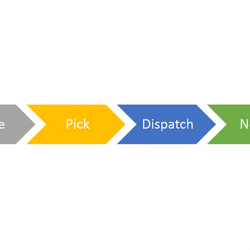
What does a perfect delivery mean? Every single happy customer. Every need is met while still controlling costs to the nth degree.
Solving the vehicle routing problem is incredibly complex — and critical to improving a company’s bottom line. Technology is advancing at a rate that changes the way deliveries are made, and harnessing it will be the key to succeeding in an increasingly competitive landscape.
Think about how much technology has changed in recent years — and how quickly it’s happened. Remember when an 8MB memory card seemed like a huge amount of space? That was only 12 years ago. Now we can get two terabytes, and at a fraction of the cost. Did you ever think that we’d rely on an app on our phone to get from place to place instead of hailing a taxi? Every day technology is evolving — new apps are available to download, new ideas become a reality.
It’s apparent that the progression of 21st century technology has changed our lives — but it has also created a multitude of solutions for suppliers to cut costs and operate more intelligently. As providers in the space begin taking advantage of vehicle-to-vehicle communication, drones, and other mobile technology improvements, the way deliveries are made has changed in a big way compared to even ten years ago.
And the bottom line is — we have to adapt. We can no longer do things the way we did them before. We can’t be satisfied with the method to get a truck out the door; it doesn’t work the same way anymore. Too much technology allows us to streamline the process and keep our customers happy.
You might hear people scoff at the idea of technologies like drones being a threat to their distribution companies. If you’re one of these people, try to shift your mind from dismissing new technologies to actually being aware of anything that could be potential competition. Competition can come from unlikely spaces, and rapidly. When Amazon was solely an online bookstore, did you ever imagine all the spaces it would be in today? Or that Google would go from online search to all that it does now, including provide maps that you use every day?
It’s important that you pay attention to all of the new technologies you see today. We’ll take three buzzworthy technologies as examples of how seemingly “out there” technology could apply to your business: drones, wearables, and 3D printing. Drones can’t do what trucks can do, but what about those customers who need last minute orders? A drone can’t fit a case of beer, but it certainly can fit that pound of shrimp that your customer needs within the hour. Wearables aren’t just about tracking your steps and monitoring your heart rate anymore — a fleet manager could get notifications right on his wrist that drivers are behind schedule. And 3D printing? Perhaps a supply company could print parts on demand rather than take up space stocking extra parts on the truck.
The point is simple — listen to what the big players are doing, be aware of unlikely competitors, and embrace technology so you can stay competitive. If you dig into what Amazon is doing, for example, you’ll see the different business functions they have and understand how they could be the next major wholesale distributor.
Returning to the perfect delivery concept, we need to think about how to meet customer expectations with the use of technology. Smartphones have made our lives better, but also ruined our lives because now we’re always connected. And this concept of being connected changes what it means to deliver. Customers expect to know instantly what time a delivery will be there. Why? Because we order deodorant on Amazon and get texts that our deodorant is coming and we receive exception alerts when it arrives. Customers want to know why you can’t tell them what time a truck will be there when Amazon can tell them when their deodorant arrived.
There are six key components of a perfect delivery: Order, Route, Pick, Dispatch, Notify, and Deliver.
- Order: It used to be that when you purchased an appliance, for example, you expected to wait several days to hear from the store and they would tell you when you’d receive your purchase. Nowadays, you’re asked what day you’d like to receive it and get to select the date and time window that you prefer. You can have the same impact on your customers. Think about customers who order items nonstop, five days a week. What if you can give them a delivery, but when it’s advantageous to you instead of spending money for hot shot deliveries? This is possible with self-scheduling technology and we’re hearing more and more about it.
- Route: Careful route planning is critical to overcome common delivery obstacles and satisfy customer demands. Routing is starting to change as we collect more and more data. We can start collecting data about who we deliver to and what their preferences are — in real time. Omnitracs Navigation is an example of a service on the market that offers turn-by-turn directions and over-the-air updates to improve the driver experience. We can leverage all the data points from routing software to enhance that driver experience through navigation with real-time and historical traffic data captured through cloud-based routing. With routing in the cloud, we get faster development, and more access to data and tools — with less IT burden on your company.
- Pick: Picking orders can be a timely process so it’s important that the picking is done correctly. With Roadnet mobile applications, you can see that picking was done properly and loaded onto the vehicle correctly. Complete a simple scan verification to make sure that the correct product is on the truck.
- Dispatch: Dispatching means tracking routes and seeing what’s happening relative to your route plan. But it also means dealing with emergencies. We need more visibility to real-time information like traffic and weather to see how things are going to change. This is all possible with today’s technology.
- Notify: Going back to the example above about receiving notifications from Amazon about your deodorant delivery — this concept of notifications is changing the way we do business. We have the ability to give people information now, and customers expect it. And it’s not just about them — when you get less calls into your service center from sales reps asking about their customers’ orders, you’re saving a lot in time and money. Proactive notifications with real-time information about deliveries can be sent to your customers and your sales reps, tailoring the messages to different constituencies.
- Deliver: The accuracy of your deliveries is very important. How many times have your drivers delivered the wrong item? That’s human error, of course, but instead of relying on a driver to remember what to deliver, technology can allow drivers to scan barcodes on packages to ensure accurate deliveries. Mobile apps make the driver experience much easier, putting workflow in front of the drivers.
Technology is changing every day and new competitors are creeping into your space with the help of new technology. To get closer to the perfect delivery, you need to work hard at ensuring you have the best technology in place to streamline your operation and enable better customer service. All of this while keeping your eyes open for potential new threats to your business. You can stay ahead of the game when you use new technology to your advantage.
